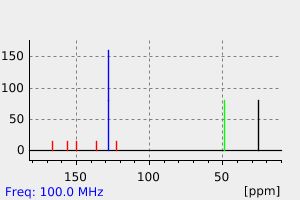9-benzyl-2-methyl-8-azaadenine | 55898-89-0
中文名称
——
中文别名
——
英文名称
9-benzyl-2-methyl-8-azaadenine
英文别名
3-benzyl-5-methyl-3H-[1,2,3]triazolo[4,5-d]pyrimidin-7-ylamine;3-Benzyl-5-methyltriazolo[4,5-d]pyrimidin-7-amine
CAS
55898-89-0
化学式
C12H12N6
mdl
——
分子量
240.267
InChiKey
WNMLHWGFKQNWDW-UHFFFAOYSA-N
BEILSTEIN
——
EINECS
——
-
物化性质
-
计算性质
-
ADMET
-
安全信息
-
SDS
-
制备方法与用途
-
上下游信息
-
文献信息
-
表征谱图
-
同类化合物
-
相关功能分类
-
相关结构分类
物化性质
-
熔点:266 °C(Solv: ethanol (64-17-5))
-
沸点:419.7±37.0 °C(Predicted)
-
密度:1.44±0.1 g/cm3(Predicted)
计算性质
-
辛醇/水分配系数(LogP):1.4
-
重原子数:18
-
可旋转键数:2
-
环数:3.0
-
sp3杂化的碳原子比例:0.17
-
拓扑面积:82.5
-
氢给体数:1
-
氢受体数:5
上下游信息
反应信息
-
作为反应物:描述:参考文献:名称:2,9-Disubstituted-N6-(arylcarbamoyl)-8-azaadenines as new selective A3 adenosine receptor antagonists: Synthesis, biochemical and molecular modelling studies摘要:A number of N-6-(N-arylcarbamoyl)-2-substituted-9-benzyl-8-azaadenines, obtained by a modification of the synthetic scheme used to prepare selective A(1) ligands, by only three or two steps, are described. At first we prepared a series of 2-phenyl-9-benzyl-8-azaadenines having as N-6 substituent a variously substituted N-phenylcarbamoyl group. Some of these derivatives demonstrated good affinity towards the A(3) subtype but low selectivity. Compounds having p-CF3, p-F and p-OCH3, as substituents on the phenylcarbamoyl group were selected as lead compounds for the second part of this study. Without modifying the N-6 substituent, which would assure A(3) affinity, we varied the 9 and 2 positions on these molecules to enhance selectivity. Some compounds having a p-methyl group on the 2-phenyl substituent showed a very good affinity and selectivity for the A(3) subtype, revealing the first class of A(3) adenosine receptor selective antagonists with a bicyclic structure strictly correlated to the adenine nucleus. The molecular modelling work, carried out using the DOCK program, supplied two models which may be useful for a better understanding of the binding modes. Both models highlighted the preferred interacting tautomeric forms of the antagonists for human A(1) and A(3) receptors. (c) 2005 Elsevier Ltd. All rights reserved.DOI:10.1016/j.bmc.2005.04.063
-
作为产物:描述:5-氨基-1-苄基-1H-1,2,3-噻唑-4-羧胺 在 氨 、 N,N-二乙基苯胺 、 三氯氧磷 作用下, 以 乙醇 为溶剂, 反应 24.0h, 生成 9-benzyl-2-methyl-8-azaadenine参考文献:名称:2,9-Disubstituted-N6-(arylcarbamoyl)-8-azaadenines as new selective A3 adenosine receptor antagonists: Synthesis, biochemical and molecular modelling studies摘要:A number of N-6-(N-arylcarbamoyl)-2-substituted-9-benzyl-8-azaadenines, obtained by a modification of the synthetic scheme used to prepare selective A(1) ligands, by only three or two steps, are described. At first we prepared a series of 2-phenyl-9-benzyl-8-azaadenines having as N-6 substituent a variously substituted N-phenylcarbamoyl group. Some of these derivatives demonstrated good affinity towards the A(3) subtype but low selectivity. Compounds having p-CF3, p-F and p-OCH3, as substituents on the phenylcarbamoyl group were selected as lead compounds for the second part of this study. Without modifying the N-6 substituent, which would assure A(3) affinity, we varied the 9 and 2 positions on these molecules to enhance selectivity. Some compounds having a p-methyl group on the 2-phenyl substituent showed a very good affinity and selectivity for the A(3) subtype, revealing the first class of A(3) adenosine receptor selective antagonists with a bicyclic structure strictly correlated to the adenine nucleus. The molecular modelling work, carried out using the DOCK program, supplied two models which may be useful for a better understanding of the binding modes. Both models highlighted the preferred interacting tautomeric forms of the antagonists for human A(1) and A(3) receptors. (c) 2005 Elsevier Ltd. All rights reserved.DOI:10.1016/j.bmc.2005.04.063
文献信息
-
“One pot” synthesis of 2,9-disubstituted 8-azaadenines (3,5-disubstituted 7-amino-3<i>H</i>-1,2,3-triazolo[4,5-<i>d</i>]pyrimidines)作者:Pier Luigi Barili、Giuliana Biagi、Oreste Livi、Luciana Mucci、Valerio ScartoniDOI:10.1002/jhet.5570240419日期:1987.7A new simple method for the synthesis of title compounds is described starting from malononitrile, benzyl-azide and an aliphatic or aromatic nitrile.
-
Three-Step Synthetic Pathway toward Fully Decorated [1,2,3]Triazolo[4,5-<i>d</i>]pyrimidine (8-Azapurine) Derivatives作者:Felien Reniers、Stijn Anthonissen、Luc Van Meervelt、Wim DehaenDOI:10.1021/acs.orglett.3c00729日期:2023.4.285-d]pyrimidines (8-azapurines) are known bioisosteres of the purine nucleus. A step-efficient synthesis of 8-azapurines, in particular 6-alkyl derivatives, is currently unavailable. This work focuses on a three-step synthetic pathway for the synthesis of fully decorated 8-azapurines, with special attention on 6-alkyl-8-azapurines. A diverse library of 8-azapurines was obtained starting from various alkynes
-
BARILI, PIER LUIGI;BIAGI, GIULIANA;LIVI, ORESTE;MUCCI, LUCIANA;SCARTONI, +, J. HETEROCYCL. CHEM., 24,(1987) N 4, 997-1001作者:BARILI, PIER LUIGI、BIAGI, GIULIANA、LIVI, ORESTE、MUCCI, LUCIANA、SCARTONI, +DOI:——日期:——
表征谱图
-
氢谱1HNMR
-
质谱MS
-
碳谱13CNMR
-
红外IR
-
拉曼Raman
-
峰位数据
-
峰位匹配
-
表征信息
同类化合物
阿扎次黄嘌呤
钠2-氨基-6-甲基-[1,2,4]三唑并[1,5-a]嘧啶-5-醇
苯酚,4-[2-[[7-氨基-2-(2-呋喃基)[1,2,4]三唑并[1,5-a][1,3,5]三嗪-5-基]氨基]乙氧基]-
替格雷洛-d7
替格瑞洛羟基杂质
替格瑞洛杂质R1788033-05-5摩科品牌提供图谱
替格瑞洛杂质K
替格瑞洛杂质J
替格瑞洛杂质H
替格瑞洛杂质F
替格瑞洛杂质85
替格瑞洛杂质27
替格瑞洛杂质
替格瑞洛杂质
替格瑞洛中间体1脱保护杂质
替格瑞洛
曲匹地尔
异亚丙基替卡格雷
布美地尔
唑嘧菌胺
唑嘧磺草胺
吡唑并[1,5-a]嘧啶-7(4H)-酮,2-甲基-6-硝基-,盐钠
去羟基乙氧基替格雷洛
去羟基乙氧基-2,3-O-(二甲基亚甲基)替格雷洛
化合物 T15173
v-三唑并[4,5-d]嘧啶,(3H),3-环戊基-7-偏基硫代-
[[[3-(4,7-二氢-7-氧代-1H-1,2,3-三唑并[4,5-d]嘧啶-5-基)-4-丙氧基苯基]氨基]亚甲基]丙二酸二乙酯
[1,2,4]噻唑并[1,5-c]嘧啶-5(6h)-酮
[1,2,4]三氮唑并[1,5-A]嘧啶-2-胺
[1,2,4]三唑并[3,4-f]嘧啶
[1,2,4]三唑并[1,5-a]嘧啶-7-酚,5-壬基-
[1,2,4]三唑并[1,5-a]嘧啶-7(1H)-酮,2-甲基-6-硝基-,盐钠
[1,2,4]三唑并[1,5-A]嘧啶-2-羧酸甲酯
[1,2,4]三唑并[1,5-A]嘧啶-2-羧酸
[1,2,4]三唑[1,5,A]嘧啶-7-氨基
[(1R,3S)-3-(5-氨基-7-氯-3H-[1,2,3]三唑并[4,5-d]嘧啶-3-基)环戊基]甲醇
[(1R,3S)-3-(5,7-二氨基-3H-[1,2,3]三唑并[4,5-d]嘧啶-3-基)环戊基]甲醇
N-甲基-1H-1,2,3-三唑并[4,5-d]嘧啶-7-胺
N-(4'-氟丁酰苯)-4-(4-氯苯基)吡啶正离子
N-(2,6-二氯苯基)-5,7-二甲基[1,2,4]三唑并[1,5-a]嘧啶-2-磺酰胺
N-(2,6-二氯-3-甲苯基)-5,7-二甲氧基-[1,2,4]三唑[1,5-a]嘧啶-2-磺酰胺
N-(2,6-二氯-3-甲基苯基)-5,7-二氯-1,2,4-三唑并[1,5-a]吡啶-2-磺酰胺
N-(1,5,6,7-四氢-3,6-二甲基-5,7-二氧代-1,2,4-三唑并[4,3-c]嘧啶-8-基)-乙酰胺
EED抑制剂(EEDINHIBITOR-1)
9H-7,8-二氢-(1,2,3)三唑并(4',5'-4,5)嘧啶并(6,1-b)(1,3)噻嗪-5(3H)-酮
9-乙基-2,4,7,8,9-五氮杂双环[4.3.0]壬-1,3,5,7-四烯-3,5-二胺
8-甲氧基-3-甲基-[1,2,4]三唑并[4,3-C]嘧啶
8-甲基-1,3,7,9-四氮杂双环[4.3.0]壬-2,4,6,8-四烯
8-溴-[1,2,4]三唑并[4,3-c]嘧啶
8-溴-5-(甲硫基)[1,2,4]三唑并[4,3-c]嘧啶







